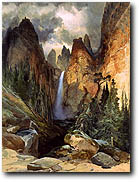%20of%20towerrooseveltbar.JPG)
Natural
Highlights of the Tower-Roosevelt Area - National Park
Service
Specimen Ridge
Specimen Ridge, located along the Northeast Entrance Road east of Tower
Junction, contains the largest concentration of petrified trees in the
world. There are also excellent samples of petrified leaf impressions,
conifer needles, and microscopic pollen from numerous species no longer
growing in the park. Specimen Ridge provides a superb "window" into
the distant past when plant communities and climatic conditions were
much different than today.
Petrified Tree
The Petrified Tree, located near
the Lost Lake trailhead, is an excellent example of an ancient redwood,
similar to many found on Specimen Ridge, that is easily accessible to
park visitors. The interpretive message here also applies to those trees
found on Specimen Ridge.
Tower Fall
Tower Fall is the most recognizable
natural feature in the district.
The 132-foot drop of Tower Creek, framed by eroded volcanic
pinnacles has been documented by park visitors from the earliest trips
of Europeans into the Yellowstone region. Its idyllic setting has inspired
numerous artists, including Thomas Moran. His
painting of Tower Fall played a crucial role in the establishment
of Yellowstone National Park in 1872. The nearby Bannock Ford on the
Yellowstone River was an important travel route for early Native Americans
as well as for early European visitors and miners up to the late 19th
century.
Calcite Springs
This grouping of thermal springs along the Yellowstone River signals
the downstream end of the Grand Canyon of the Yellowstone. The geothermally
altered rhyolite inspired the artist Moran; his paintings of this scene
were among those presented to Congress in 1872, leading to the establishment
of the park. The steep, columnar basalt cliffs on the opposite side
of the river from the overlook are remnants of an ancient lava flow,
providing a window into the past volcanic forces that shaped much of
the Yellowstone landscape. The gorge and cliffs provide habitat for
numerous wildlife species including bighorn sheep, red-tailed hawks,
and osprey.
"The Essenstials for
Planning your
Trip to Yellowstone Park" |
|
|
|
|
Historic
Highlights of the Tower-Roosevelt Area - National Park Service
The Buffalo Ranch
The Lamar Buffalo Ranch was built in the early part of the century in
an effort to increase the herd size of the few remaining bison in Yellowstone,
preventing the feared extinction of the species. Buffalo ranching operations
continued at Lamar until the 1950s. The valley was irrigated for hay
pastures, and corrals and fencing were scattered throughout the area.
Remnants of irrigation ditches, fencing, and water troughs can still
be found. Four remaining buildings from the original ranch compound
are contained within the Lamar Buffalo Ranch Historic District (two
residences, the bunkhouse, and the barn) and are on the National Register
of Historic Places. In the early 1980s, old tourist cabins from Fishing
Bridge were brought to Lamar to be used for Yellowstone Institute classes.
In 1993, a cabin replacement project, funded by the Yellowstone Association,
was begun. At this time all of the old cabins have been replaced with
new insulated and heated structures. The facility is also used in the
spring and fall for the Park Service's residential environmental education
program, Expedition: Yellowstone! You are welcome to drive by to view
the historic buffalo ranch, however, there are no facilities open to
the general public at this location.
The Tower Ranger Station & Roosevelt
National Historic District
The Tower Ranger Station, though not on the National Register of Historic
Places, is a remodeled reconstruction of the second Tower Soldier Station,
which was built in 1907. The Roosevelt Lodge was constructed in 1920
and has been determined eligible for the National Register of Historic
Places. The Roosevelt National Historic District also includes the Roosevelt
cabins. Interestingly, one of the reasons Roosevelt Lodge was nominated
for the National Register was due to its important role in early park
interpretation.
Pleasant Valley
Pleasant Valley was the sight of "Uncle John" Yancey's Pleasant Valley
Hotel, one of the earliest lodging facilities in Yellowstone. The hotel
and outbuildings were built between 1884 and 1893 and served early park
visitors as well as miners passing through en route to the mining district
near Cooke City. Currently, the site is used by the park's main concessioner,
Amfac, for their "Old West" cookouts. None of the original buildings
remain.
The Northeast Entrance Ranger Station
The Northeast Entrance Ranger Station
was constructed in 1934-35 and is a National Historic Landmark. It's
rustic log construction is characteristic of "parkitecture" common in
the national parks of the west during that period.
The Bannock Trail
The Bannock Trail, once used by Native Americans to access the buffalo
plains east of the park from the Snake River plains in Idaho, was extensively
used from approximately 1840 to 1876. A lengthy portion of the trail
extends through the Tower District from the Blacktail Plateau (closely
paralleling or actually covered by the existing road) to where it crosses
the Yellowstone River at the Bannock Ford upstream from Tower Creek.
From the river, the trail's main fork ascends the Lamar River splitting
at Soda Butte Creek. From there, one fork ascends the creek before leaving
the park. Traces of the trail can still be plainly seen in various locations,
particularly on the Blacktail Plateau and at the Lamar-Soda Butte confluence.
Archeological Resources
There are many archaeological sites in the Tower District. In fact,
sites are found in a greater density here than in most other areas of
the park. Unfortunately, most have yet to be extensively catalogued
or studied.
|

